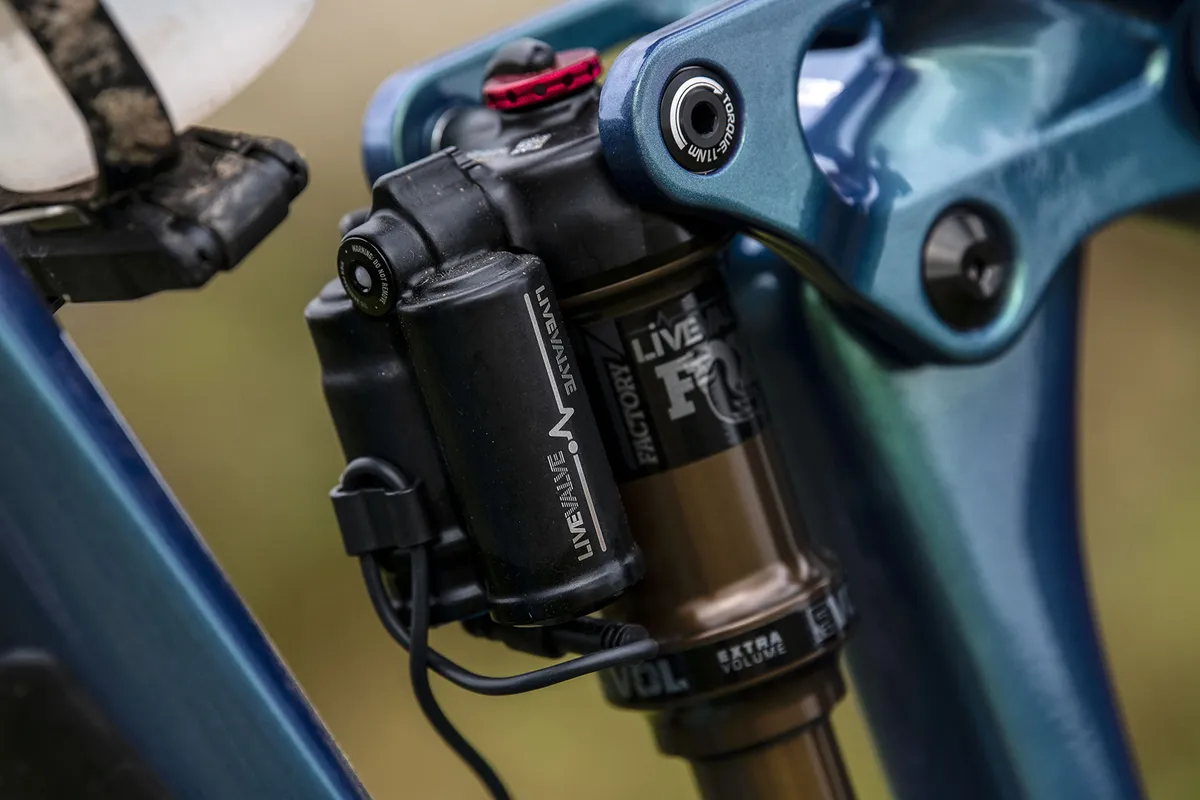Fox has filed a patent outlining two separate inventions that work in unison to combat the adverse effects chain tension has on a bike's rear suspension.
The ‘Suspension Enhancing Hub and Rear Derailleur Assembly’ describes a rear hub and derailleur that automatically disengage, improving suspension sensitivity and performance.
The filing comes off the back of increased interest in how pedal kickback can affect performance – products such as the O-Chain and the increased popularity of high-pivot bikes with idler pulleys all show manufacturers' focus on minimising pedal kickback.
Here, we’ll examine what Fox’s new tech means, how it works and the implications for the future of suspension performance as a whole.
What is pedal kickback?
The rear axle moves further away from the bottom bracket at some point through the compression of almost all mountain bike rear suspension systems.
To compensate for this, the rear-derailleur cage moves forward, feeding more chain onto the cassette, which in turn feeds more chain into the upper span, enabling it to grow with the axle movement.
The cassette can’t spin faster than the wheel because the freehub's rotation is locked to the rear-wheel rotation. This means at slow speeds, or when the rear wheel is locked up, the cassette can’t provide slack to the upper of the chain.
This causes the chain to move backwards, which in turn rotates the cranks backwards to allow for the chain growth required for suspension compression.
This is called pedal kickback. The sharp rotation of the cranks makes it feel as though the bike is overly firm and can make it harder to keep your feet in place if you ride with flat pedals.
Pedal kickback also reduces the sensitivity of the rear suspension as more force is put through the linkage.
What has Fox filed for?

First spotted by Bikerumour, the patent describes a hub with pawls that automatically and electronically disengage, essentially allowing for a neutral gear.
This isolates the chain from suspension, allowing the cassette to move freely, which in turn could offer better suspension sensitivity.

This is paired with an electronic rear derailleur assembly. It consists of a mounting component, a parallelogram component for shifting through the cassette and a ‘P-Knuckle’ housing a clutch mechanism.
This is connected to a short cage with an upper and lower pulley wheel – so far so familiar.
However, Fox’s patent describes a system consisting of a motor, gear, spring, linear solenoid, torsional power spring, clutch plate, and at least one thrust bearing that can automatically disengage the clutch.
The patent suggests sensors and processors would control engagement for both the rear derailleur and hub. It also suggests an override switch that would enable riders to control the system through a bar-mounted switch, similar to a dropper post.
What is a derailleur clutch?
A derailleur clutch works in tandem with a tension spring to put tension on the chain, keeping it in place over rough terrain by pulling it tight around the chainring and cassette.
Without this, the chain can slap the chainstay, making a horrendous noise and sometimes damaging the frame.
Clutches were introduced to rear derailleurs as 1x drivetrains gained prominence. Extra chain tension was needed due to the removal of the front derailleur, which acts as a chain guide, stopping the chain from jumping off the front chainring.
Why is Fox doing this?
Chain tension is a hot topic in the world of mountain biking, with new frame designs and innovations created to combat this issue.
Fox isn’t the first brand to propose a 'disengageable' rear hub, with Canyon prototyping its DisConnect on-the-fly 'disconnectable' freehub in 2016.
High-pivot linkages are an increasingly popular frame design for downhill and enduro bikes, with many manufacturers choosing the linkage for its rearwards axle path and idler pulley.
The idler pulley routes the chain near or concentric to the main high-pivot location, minimising pedal kickback (check out our high-pivot explainer for more detail).
The Ochain Active Spider has also seen great success in the downhill World Cup and Enduro World Series.
This works by allowing the chainring to rotate backwards by either 6, 9, or 12 degrees, reducing the amount of kickback you feel through the pedals.
The Ochain does have a noticeable slack between pedalling and the freehub engaging. Fox’s patent suggests it would be able to avoid this by using sensors on the bike that can ‘re-engage’ the freehub when the rider starts pedalling.
Where could we see these innovations?

As with any patent, it's unknown whether this technology will ever see the light of day.
Should the products ever be released, we expect they will be under the Race Face components banner. Race Face is owned by Fox and the brand already makes hubs, cranksets and chainrings.
The hub shown in the patent also looks similar to the design of the Vault Hub, with the pawls being installed on the hub's shell rather than the more conventional method of placing them on the freehub body. This gives plenty of room for electronics inside the hub.
The new patents suggest Fox has ambitions of producing an electronic groupset to rival SRAM, the company that owns RockShox.

It's likely the system would integrate into the Fox Live Valve ecosystem, which electronically controls suspension dampening, self-adjusting to real-time terrain and rider inputs.
Fox’s Live Valve system also features numerous sensors that could deliver information to the system.
Fox has also been developing a wireless shock controller similar to RockShox’s Flight Attendant in its RAD program, which features a wireless rear-brake sensor.
All eyes will be on the downhill pits this year for a glimpse of any prototypes.
Could this change everything?
While there have been other systems that isolate the drivetrain from the effects of suspension, nothing has yet been undertaken by a brand the size of Fox.
Considering its relationship with OEMs, it’s likely any design from Fox will have an impact on the wider market.
When designing suspension linkages, bike manufacturers have to take into account chain tension. It isn’t far-fetched to suggest whatever Fox comes up with could change the way bike frames are designed.
New suspension designs that don’t have to consider the effects of chain growth would allow for a higher level of sensitivity from the rear shock, and enable it to perform better over smaller impacts.
It's also likely that other electric component manufacturers, such as SRAM, may develop similar tech that integrates into its AXS ecosystem.
Whether these innovations ever make it to market is unknown, and so too is how far they may trickle down from their perceived use case on downhill and enduro bikes.

